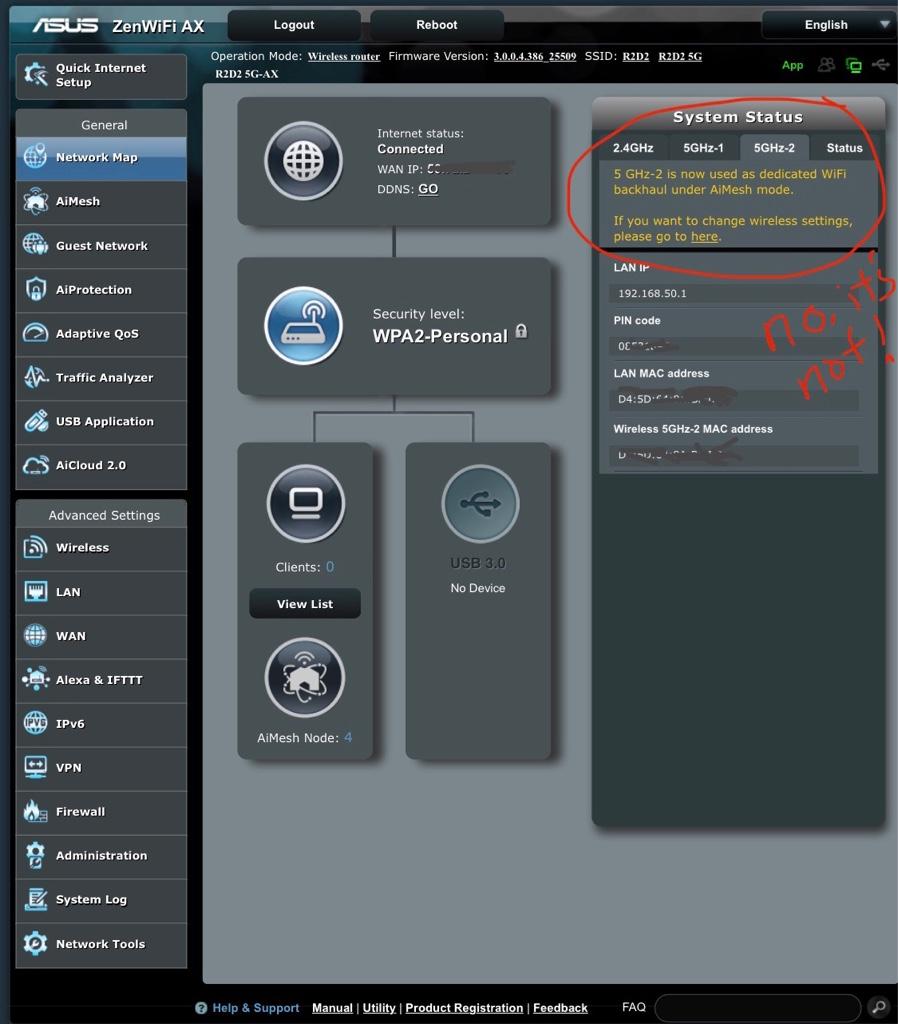First, this idea was great and I have not ever even enabled SSH previously, so that was a great new idea I liked.
Second, I learned that my drop back to firmware 25217 only took place on the primary device and AIMESH device was still running 25524 and I guess because of the mismatch I couldn't even enable SSH. It said it did it, but was never listening.
I updated primary back to 25524 and SSH was enabled.
I proceeded to follow your steps, but it failed----the write occurred without error, but again it didn't take. Below is full output (username REDACTED for privacy). The big note is original file was 1200 bytes, updated file was 1234 after adding one new MAC and IP. I looked in GUI and didn't see the add. So, I went back and pulled again to dhcp2.txt and noticed it truncated back down to 1200. Therefore, it seems ASUS plan to support 64 devices miss calculated the byte count.
MYUSER@ZenWiFi_XT8-DA50:/tmp/home/root# cat dhcp.txt
<9C:F3:87:CA:06:4A>192.168.50.80><D0:52:A8:00:5D:9B>192.168.50.60><04:52:F3:52:69:2E>192.168.50.83><D0:C5:F3:4A:31:0A>192.168.50.102><64:76:BA:91:8A:7A>192.168.50.100><4C:EF:C0:3B:F8:88>192.168.50.76><34

2:70:9D:9D:E5>192.168.50.63><C4:1C:FF:B3:C2:AA>192.168.50.78><CC:88:26:0D:A1:7D>192.168.50.99><54:13:79:0B:5F:75>192.168.50.101><50:F5

A:88:24

0>192.168.50.62><DC:A9:04:2C:EC

A>192.168.50.82><00:05:CD:90:6D:27>192.168.50.73><00:5B:94:9C:E7:48>192.168.50.107><D8:BB:2C:83:12:29>192.168.50.125><14:0A:C5:83:69:F8>192.168.50.71><60:8C:4A

8:02:5F>192.168.50.124><78:88:6D:74:FA:0C>192.168.50.121><5C:41:5A:59:85:BC>192.168.50.79><38:F7:3D:3C:50:8F>192.168.50.77><DC:A6:32:06:32:F8>192.168.50.22><5C:F6

C:17:BE:E6>192.168.50.65><00:24:BE:F3:0F

7>192.168.50.68><5C:52:1E:61:1E:73>192.168.50.126><2C:6F:C9:16:94:96>192.168.50.21><38:F7:3D:93:13:B0>192.168.50.81><00:12:FB:CE:99:EC>192.168.50.67><90:B9:31:94:2A:53>192.168.50.103><FC:A6:67:C0:4E:2A>192.168.50.74><B4:7C:9C:B8:6B:77>192.168.50.64><6C:56:97:EE:76:8E>192.168.50.75><CC:B0

A:B1:38:43>192.168.50.120><FC:A1:83:F3:7F:85>192.168.50.69><50

4:F7:E6:8A:F7>192.168.50.66><38:F9

3:99:21:F3>192.168.50.110><68:64:4B:14:B2

2>192.168.50.70><70:66:55:7F:8E:55>192.168.50.127>
MYUSER@ZenWiFi_XT8-DA50:/tmp/home/root# nvram set dhcp_staticlist=`cat dhcp.txt`
MYUSER@ZenWiFi_XT8-DA50:/tmp/home/root# ls -al
drwx------ 3 MYUSER root 80 Jul 7 17:08
.
drwxr-xr-x 3 MYUSER root 60 Dec 31 1969
..
drwx------ 2 MYUSER root 60 May 5 2018
.ssh
-rw-rw-rw- 1 MYUSER root 1234 Jul 7 17:18 dhcp.txt
MYUSER@ZenWiFi_XT8-DA50:/tmp/home/root# nvram get dhcp_staticlist > dhcp2.txt
MYUSER@ZenWiFi_XT8-DA50:/tmp/home/root# ls -al
drwx------ 3 MYUSER root 100 Jul 7 17:21
.
drwxr-xr-x 3 MYUSER root 60 Dec 31 1969
..
drwx------ 2 MYUSER root 60 May 5 2018
.ssh
-rw-rw-rw- 1 MYUSER root 1234 Jul 7 17:18 dhcp.txt
-rw-rw-rw- 1 MYUSER root 1200 Jul 7 17:21 dhcp2.txt
MYUSER@ZenWiFi_XT8-DA50:/tmp/home/root#


